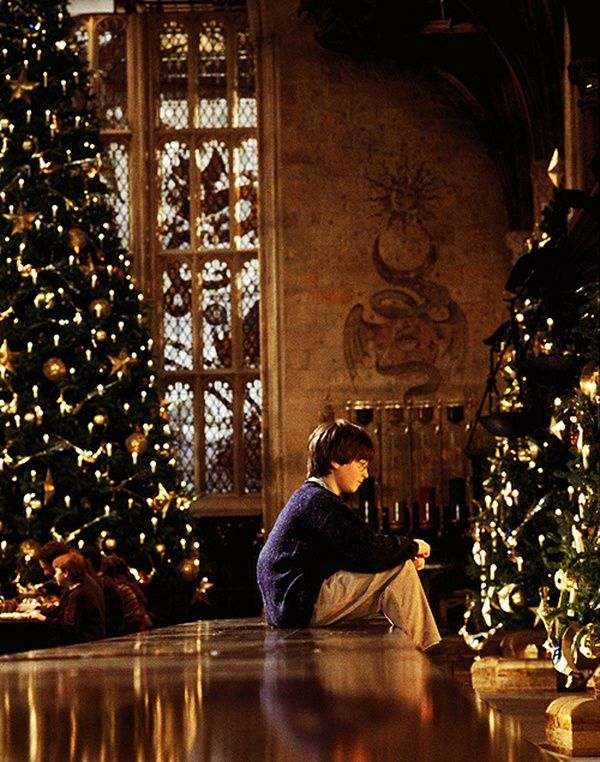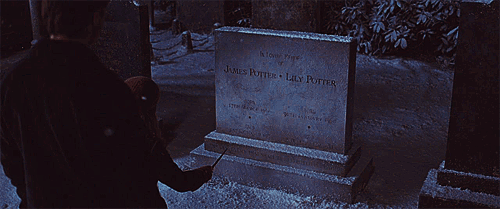Carols in Harry Potter And The Myth Of The Christmas Rose (Part 2)

Dec 24, 2018
News, Opinion
Christmas Eve has arrived, and guest writer Dr Beatrice Groves (author of Literary Allusion in Harry Potter) returns to unpack more festive themes in the Potter series, including a new discovery of links to Rossetti’s A Christmas Carol, and an analysis of Hermione and Harry’s visit to Godric’s Hollow on Christmas Eve.
Read Part 1 here.
Yesterday I argued that the myth of the Christmas rose underlies the comforting appearance of the flower on Christmas night in Deathly Hallows. This myth is also, I think, an unrecognised source for one of our most popular carols: Christina Rossetti’s ‘In the Bleak Mid-winter.’
Rossetti’s poem was first published in 1872 under the title ‘A Christmas Carol.’ It was set to music by Holst at the beginning of the twentieth century but the slightly later setting by Harold Darke has since gained even more popularity (see above). Rossetti is a favourite poet of Rowling’s: she even took the title of one of her novel’s (Cuckoo’s Calling) from a Rossetti poem. And Rossetti’s imagining of the first Christmas night – though often complained of as not terribly suited to Palestine – perfectly evokes an English Christmas Eve:
In the bleak mid-winter, frosty wind made moan,
Earth stood hard as iron, water like a stone;
Snow had fallen, snow on snow, snow on snow.
Harry stands in a similarly bleak mid-winter night thinking of how his parents lie ‘beneath snow and stone’ (Deathly Hallows, Chap 16). At this moment Harry wishes he had a gift to give his parents and Hermione conjures for him a wreath of Christmas roses.
The story of appearing full-hearted but empty-handed at the stable on Christmas night – the story behind the myth of the Christmas rose – also has clear parallels with ‘In the Bleak Mid-winter.’
“In the bleak mid-winter, frosty wind made moan,
Earth stood hard as iron, water like a stone;
Snow had fallen, snow on snow, snow on snow,
In the bleak mid-winter, long ago.
Our God, Heaven cannot hold Him, nor earth sustain;
Heaven and earth shall flee away when He comes to reign.
In the bleak mid-winter a stable place sufficed
The Lord God Almighty, Jesus Christ.
Enough for Him, whom cherubim, worship night and day,
Breastful of milk, and a mangerful of hay;
Enough for Him, whom angels fall before,
The ox and ass and camel which adore.
Angels and archangels may have gathered there,
Cherubim and seraphim thronged the air;
But His mother only, in her maiden bliss,
Worshipped the beloved with a kiss.
What can I give Him, poor as I am?
If I were a shepherd, I would bring a lamb;
If I were a Wise Man, I would do my part;
Yet what I can I give Him: give my heart.”
The speaker’s anxiety about what they, in their poverty, have to offer the Christ child – as well as the poem’s triumphant response that love is all Jesus would wish for as gift – resonates closely with the Christmas rose story. Indeed, it seems more than possible that Rossetti (although she leaves out the magically-appearing flower) imagines us into the role of the poor shepherd child in the Christmas rose story. The Christmas rose in that story is a metaphor for the way in which the poor shepherd’s child, in longing to give a gift to the new-born baby, has already given him all that he would wish from them: their love.
In answer to my opening question yesterday – ‘how many Christmas carols are sung in Harry Potter?’ – is that, of course, along with the unspecified carols sung at Hogwarts and Godric’s Hollow, we only know that versions of ‘God rest you Merry Gentlemen’ and ‘O Come all ye Faithful,’ are sung. But it would be beautifully fitting, in terms of the underlying symbolism of the carol, if ‘In the Bleak Mid-winter’ should be one of the carols drifting over Harry and Hermione as they stand in the snow in Godric’s Hollow churchyard and lay a wreath of Christmas roses on his beloved parents’ grave.

And, finally, where does the Christmas rose appear in Potions? In Phoenix, under the watchful eyes of Snape, Harry attempts to make a Draught of Peace: ‘allow to simmer for seven minutes then add two drops of syrup of Hellebore’ (Phoenix, Chap 12).
The Latin name for the Christmas rose is Helleborus niger (which means ‘black’ hellebore – it has white flowers, but is named after its black root). Rowling has spelt out in detail (with reference to Polyjuice Potion) the way in which she chooses her potions’ ingredients in order to echo their effects. This doesn’t just happen with Polyjuice Potion – if you dig down into any of Rowling’s potions you will find ingredients that echo the effect of the potion. What ingredient is on the work bench (busily being flicked at Ron and Harry by Malfoy) when they are making Swelling Solution? Puffer fish eyes (the eyes of a fish that ingests water and swells up as a response to attack). Meanwhile, squeezing the liquid-filled pustules on Bubotubers is just like squeezing spots (right down to the icky satisfaction of it). And what is its pus used to cure? Acne, of course. Above all it is Rowling’s plants that follow this path and she wittily uses flowers that will be perfect for her potions.
In the language of flowers the hellebore or Christmas rose means ‘Relieve my anxiety.’ This makes it the perfect flower to use an ingredient in a Draught of Peace, but I think the Christmas association is even more important.
‘“Add powdered moonstone, stir three times counter-clockwise, allow to simmer for seven minutes then add two drops of syrup of hellebore.”’
His heart sank. He had not added syrup of hellebore, but had proceeded straight to the fourth line of the instructions after allowing his potion to simmer for seven minutes. ‘Did you do everything on the third line, Potter?’
‘No,’ said Harry very quietly.
‘I beg your pardon?’
‘No,’ said Harry, more loudly. ‘I forgot the hellebore.’
‘I know you did, Potter, which means that this mess is utterly worthless. Evanesce.’
The contents of Harry’s potion vanished; he was left standing foolishly beside an empty cauldron. (Phoenix, Chap 12)

There is a nice circularity here to Harry’s failure to add the hellebore/Christmas rose, and the following disappearance of his potion, with the magical appearance of Christmas roses/hellebores in Deathly Hallows. But there is an even more satisfying circularity in the way in which his failure to add the hellebore means that he fails to make a Draught of Peace, while the appearance of hellebores in Deathly Hallows will bring him peace.
Rowling takes considerable care over her Potions’ ingredients and the hellebore belongs to the Draught of Peace not only because it is white, and because it means ‘relieve my anxiety’ but also because it is the Christmas rose. The Christmas rose brings peace to all the children who receive it in the various versions of its story, and it is essential to the Draught of Peace because Christmas is the celebration of the Prince of Peace.
Happy Christmas.
We’d like to thank Bea for her thorough analysis of Christmas in Harry Potter, and for helping us get in the festive spirit! Read her analysis of the History of Magic exhibition here, her in-depth look at plant lore in Harry Potter, and be sure to check out Dr Groves’ book, Literary Allusion In Harry Potter, and follow her on Twitter!


